Clustering Analysis of Seismicity in the Anatolian Region with Implications for Seismic Hazard
Abstract
1. Introduction
1.1. Current State of Knowledge
1.2. Aim of the Work
2. Methods
2.1. Catalogue Completeness
2.2. Coefficients of Variation
2.3. b-Value
3. Analysis and Results
4. Discussion
4.1. Seismotectonic Context and Historical Seismicity
4.2. Clustering and Scaling Properties of Turkish Seismicity and Its Regional Variability
4.3. Seismic Activity in the Kahramanmaraş Region
4.4. Implications and Physical Interpretation
5. Conclusions
Author Contributions
Funding
Institutional Review Board Statement
Data Availability Statement
Acknowledgments
Conflicts of Interest
References
- Kagan, Y.Y.; Knopoff, L. Random stress and earthquake statistics: Time dependence. Geophys. J. Int. 1987, 88, 723–731. [Google Scholar] [CrossRef]
- Zaccagnino, D.; Telesca, L.; Doglioni, C. Scaling properties of seismicity and faulting. Earth Planet. Sci. Lett. 2022, 584, 117511. [Google Scholar] [CrossRef]
- Dieterich, J.H.; Smith, D.E. Nonplanar faults: Mechanics of slip and off-fault damage. In Mechanics, Structure and Evolution of Fault Zones; Ben-Zion, Y., Sammis, C., Eds.; Springer: Basel, Switzerland, 2010; pp. 1799–1815. [Google Scholar]
- Kagan, Y.Y.; Jackson, D.D. Spatial aftershock distribution: Effect of normal stress. J. Geophys. Res. Solid Earth 1998, 103, 24453–24467. [Google Scholar] [CrossRef]
- Liu, Y.K.; Ross, Z.E.; Cochran, E.S.; Lapusta, N. A unified perspective of seismicity and fault coupling along the San Andreas Fault. Sci. Adv. 2022, 8, eabk1167. [Google Scholar] [CrossRef]
- Volpe, G.; Pozzi, G.; Carminati, E.; Barchi, M.R.; Scuderi, M.M.; Tinti, E.; Aldega, L.; Marone, C.; Collettini, C. Frictional controls on the seismogenic zone: Insights from the Apenninic basement, Central Italy. Earth. Planet. Sci. Lett. 2022, 583, 117444. [Google Scholar] [CrossRef]
- Dieterich, J.H. Earthquake simulations with time-dependent nucleation and long-range interactions. Nonlinear Process. Geophys. 1995, 2, 109–120. [Google Scholar] [CrossRef]
- Knopoff, L.; Levshina, T.; Keilis-Borok, V.I.; Mattoni, C. Increased long-range intermediate-magnitude earthquake activity prior to strong earthquakes in California. J. Geophys. Res. Solid Earth 1996, 101, 5779–5796. [Google Scholar] [CrossRef]
- Vallianatos, F.; Papadakis, G.; Michas, G. Generalized statistical mechanics approaches to earthquakes and tectonics. Proc. Math. Phys. Eng. Sci. 2016, 472, 20160497. [Google Scholar] [CrossRef]
- Sornette, D.; Sammis, C.G. Complex critical exponents from renormalization group theory of earthquakes: Implications for earthquake predictions. J. Phys. I 1995, 5, 607–619. [Google Scholar] [CrossRef]
- Mintzelas, A.; Sarlis, N.V. Minima of the fluctuations of the order parameter of seismicity and earthquake networks based on similar activity patterns. Physica A 2019, 527, 121293. [Google Scholar] [CrossRef]
- Varotsos, P.A.; Sarlis, N.V.; Skordas, E.S. Phenomena preceding major earthquakes interconnected through a physical model. Ann. Geophys. 2019, 37, 315–324. [Google Scholar] [CrossRef]
- Skordas, E.S.; Christopoulos, S.R.G.; Sarlis, N.V. Detrended fluctuation analysis of seismicity and order parameter fluctuations before the M7.1 Ridgecrest earthquake. Nat. Hazards 2020, 100, 697–711. [Google Scholar] [CrossRef]
- Griffin, J.D.; Stirling, M.W.; Wang, T. Periodicity and clustering in the long-term earthquake record. Geophys. Res. Lett. 2020, 47, e2020GL089272. [Google Scholar] [CrossRef]
- Samadi, H.R.; Kimiaefar, R.; Hajian, A. Robust Earthquake Cluster Analysis Based on K-Nearest Neighbor Search. Pure Appl. Geophys. 2020, 177, 5661–5671. [Google Scholar] [CrossRef]
- Seydoux, L.; Balestriero, R.; Poli, P.; Hoop, M.D.; Campillo, M.; Baraniuk, R. Clustering earthquake signals and background noises in continuous seismic data with unsupervised deep learning. Nat. Commun. 2020, 11, 3972. [Google Scholar] [CrossRef]
- Wozniakowska, P.; Eaton, D.W. Machine learning-based analysis of geological susceptibility to induced seismicity in the Montney Formation, Canada. Geophys. Res. Lett. 2020, 47, e2020GL089651. [Google Scholar] [CrossRef]
- Yuan, R. An improved K-means clustering algorithm for global earthquake catalogs and earthquake magnitude prediction. J. Seismol. 2021, 25, 1005–1020. [Google Scholar] [CrossRef]
- Hillers, G.; Mai, P.M.; Ben-Zion, Y.; Ampuero, J.P. Statistical properties of seismicity of fault zones at different evolutionary stages. Geophys. J. Int. 2007, 169, 515–533. [Google Scholar] [CrossRef]
- Goh, K.I.; Barabasi, A.L. Burstiness and memory in complex systems. Europhys. Lett. 2008, 81, 48002. [Google Scholar] [CrossRef]
- Lennartz, S.; Livina, V.N.; Bunde, A.; Havlin, S. Long-term memory in earthquakes and the distribution of interoccurrence times. Europhys. Lett. 2008, 81, 69001. [Google Scholar] [CrossRef]
- Sardeli, E.; Michas, G.; Pavlou, K.; Vallianatos, F.; Karakonstantis, A.; Chatzopoulos, G. Complexity of Recent Earthquake Swarms in Greece in Terms of Non-Extensive Statistical Physics. Entropy 2023, 25, 667. [Google Scholar] [CrossRef]
- Zaccagnino, D.; Telesca, L.; Doglioni, C. Global versus local clustering of seismicity: Implications with earthquake prediction. Chaos Solitons Fractals 2023, 170, 113419. [Google Scholar] [CrossRef]
- Tan, O. Turkish Homogenized Earthquake Catalogue (TURHEC). Nat. Hazards Earth Syst. Sci. (NHESS) 2021. [Google Scholar] [CrossRef]
- Tan, O. A homogeneous earthquake catalogue for Turkey. Nat. Hazards Earth Syst. Sci. 2021, 21, 2059–2073. [Google Scholar] [CrossRef]
- Wiemer, S.; Wyss, M. Minimum magnitude of completeness in earthquake catalogs: Examples from Alaska, the western United States, and Japan. Bull. Seismol. Soc. Am. 2000, 90, 859–869. [Google Scholar] [CrossRef]
- Woessner, J.; Wiemer, S. Assessing the quality of earthquake catalogues: Estimating the magnitude of completeness and its uncertainty. Bull. Seismol. Soc. Am. 2005, 95, 684–698. [Google Scholar] [CrossRef]
- Kagan, Y.Y.; Jackson, D.D. Long-term earthquake clustering. Geophys. J. Int. 1991, 104, 117–133. [Google Scholar] [CrossRef]
- Chelidze, T.; Vallianatos, F.; Telesca, L. Complexity of Seismic Time Series: Measurement and Application; Elsevier: Amsterdam, The Netherlands, 2018. [Google Scholar]
- Shinomoto, S.; Miura, K.; Koyama, S. A measure of local variation of inter-spike intervals. Biosystems 2005, 79, 67–72. [Google Scholar] [CrossRef]
- Tinti, S.; Mulargia, F. Confidence intervals of b values for grouped magnitudes. Bull. Seismol. Soc. Am. 1987, 77, 2125–2134. [Google Scholar]
- Aki, K. Maximum likelihood estimate of b in the formula log N = a-bM and its confidence limits. Bull. Earthq. Res. Inst. 1965, 43, 237–239. [Google Scholar]
- Melgar, D.; Taymaz, T.; Ganas, A.; Crowell, B.; Öcalan, T.; Kahraman, M.; Tsironi, V.; Yolsal-Çevikbilen, S.; Valkaniotis, S.; Irmak, T.S.; et al. Sub- and super-shear ruptures during the 2023 Mw 7.8 and Mw 7.6 earthquake doublet in SE Türkiye. Seismica 2023, 2. [Google Scholar] [CrossRef]
- Ozalaybey, S.; Ergin, M.; Aktar, M.; Tapirdamaz, C.; Biçmen, F.; Yörük, A. The 1999 Izmit earthquake sequence in Turkey: Seismological and tectonic aspects. Bull. Seismol. Soc. Am. 2002, 92, 376–386. [Google Scholar] [CrossRef]
- Mcclusky, S.; Balassanian, S.; Barka, A.; Demir, C.; Ergintav, S.; Georgiev, I.; Gurkan, O.; Hamburger, M.; Hurst, K.; Kahle, H.; et al. Global Positioning System constraints on plate kinematics and dynamics in the eastern Mediterranean and Caucasus. J. Geophys. Res. Solid Earth 2000, 105, 5695–5719. [Google Scholar] [CrossRef]
- Reilinger, R.; McClusky, S.; Vernant, P.; Lawrence, S.; Ergintav, S.; Cakmak, R.; Ozener, H.; Kadirov, F.; Guliev, I.; Stepanyan, R.; et al. GPS constraints on continental deformation in the Africa-Arabia-Eurasia continental collision zone and implications for the dynamics of plate interactions. J. Geophys. Res. Solid Earth 2006, 111. [Google Scholar] [CrossRef]
- Akinci, A.; Malagnini, L.; Herrmann, R.B.; Gok, R.; Sørensen, M.B. Ground motion scaling in the Marmara region, Turkey. Geophys. J. Int. 2006, 166, 635–651. [Google Scholar] [CrossRef]
- Ansal, A.; Akinci, A.; Cultrera, G.; Erdik, M.; Pessina, V.; Tönük, G.; Ameri, G. Loss estimation in Istanbul based on deterministic earthquake scenarios of the Marmara Sea region (Turkey). Soil Dyn. Earthq. Eng. 2009, 29, 699–709. [Google Scholar] [CrossRef]
- Murru, M.; Akinci, A.; Falcone, G.; Pucci, S.; Console, R.; Parsons, T. M ≥ 7 earthquake rupture forecast and time-dependent probability for the Sea of Marmara region, Turkey. J. Geophys. Res. Solid Earth 2016, 121, 2679–2707. [Google Scholar] [CrossRef]
- Lange, D.; Kopp, H.; Royer, J.Y.; Henry, P.; Çakir, Z.; Petersen, F.; Sakic, P.; Ballu, V.; Bialas, J.; Özeren, M.S.; et al. Interseismic strain build-up on the submarine North Anatolian Fault offshore Istanbul. Nat. Commun. 2019, 10, 3006. [Google Scholar] [CrossRef]
- Barka, A.; Reilinger, R. Active Tectonics of the Eastern Mediterranean Region: Deduced from GPS, Neotectonic and Seismicity Data. 1997. Available online: http://hdl.handle.net/2122/1520 (accessed on 9 April 2023).
- Hartleb, R.D.; Dolan, J.F.; Akyüz, H.S.; Yerli, B. A 2000-year-long paleoseismologic record of earthquakes along the central North Anatolian Fault, from trenches at Alayurt, Turkey. Bull. Seismol. Soc. Am. 2003, 93, 1935–1954. [Google Scholar] [CrossRef]
- Emre, Ö.; Kondo, H.; Özalp, S.; Elmaci, H. Fault geometry, segmentation and slip distribution associated with the 1939 Erzincan earthquake rupture along the North Anatolian fault, Turkey. Geol. Soc. Spec. Publ. 2021, 501, 23–70. [Google Scholar] [CrossRef]
- Barka, A. The 17 august 1999 Izmit earthquake. Science 1999, 285, 1858–1859. [Google Scholar] [CrossRef]
- Burgmann, R.; Ayhan, M.E.; Fielding, E.J.; Wright, T.J.; McClusky, S.; Aktug, B.; Demir, C.; Lenk, O.; Tu, A. Deformation during the 12 November 1999 Duzce, Turkey, earthquake, from GPS and InSAR data. Bull. Seismol. Soc. Am. 2002, 92, 161–171. [Google Scholar] [CrossRef]
- Melis, N.S.; Okal, E.A.; Synolakis, C.E.; Kalogeras, I.S.; Kânoglu, U. The Chios, Greece earthquake of 23 july 1949: Seismological reassessment and tsunami investigations. Pure Appl. Geophys. 2020, 177, 1295–1313. [Google Scholar] [CrossRef]
- Jamalreyhani, M.; Büyükakpınar, P.; Cesca, S.; Dahm, T.; Sudhaus, H.; Rezapour, M.; Isken, M.P.; Asayesh, B.M.; Heimann, S. Seismicity related to the eastern sector of Anatolian escape tectonic: The example of the 24 January 2020 Mw 6.77 Elazig-Sivrice earthquake. Solid Earth Discuss. 2020, 1–22. [Google Scholar] [CrossRef]
- Ambraseys, N.N.; Tchalenko, J.S. Seismotectonic aspects of the Gediz, Turkey, earthquake of March 1970. Geophys. J. Int. 1972, 30, 229–252. [Google Scholar] [CrossRef]
- Tan, O.; Tapirdamaz, M.C.; Yörük, A. The earthquake catalogues for Turkey. Turk. J. Earth Sci. 2008, 17, 405–418. [Google Scholar]
- Zaccagnino, D.; Telesca, L.; Doglioni, C. Variable seismic responsiveness to stress perturbations along the shallow section of subduction zones: The role of different slip modes and implications for the stability of fault segments. Front. Earth Sci. 2022, 10, 989697. [Google Scholar] [CrossRef]
- Kwiatek, G.; Martínez-Garzón, P.; Becker, D.; Dresen, G.; Cotton, F.; Beroza, G.; Acarel, D.; Ergintav, S.; Bohnhoff, M. Months-long preparation of the 2023 MW 7.8 Kahramanmaraş earthquake, Türkiye. Preprint 2023. [Google Scholar] [CrossRef]
- Romanet, P.; Sato, D.S.; Ando, R. Curvature, a mechanical link between the geometrical complexities of a fault: Application to bends, kinks and rough faults. Geophys. J. Int. 2020, 223, 211–232. [Google Scholar] [CrossRef]
- Zaccagnino, D.; Doglioni, C. The impact of faulting complexity and type on earthquake rupture dynamics. Commun. Earth Environ. 2022, 3, 258. [Google Scholar] [CrossRef]
- Cochran, E.S.; Page, M.T.; van der Elst, N.J.; Ross, Z.E.; Trugman, D.T. Fault Roughness at Seismogenic Depths and Links to Earthquake Behavior. Seism. Rec. 2023, 3, 37–47. [Google Scholar] [CrossRef]
- Goebel, T.H.W.; Brodsky, E.E.; Dresen, G. Fault roughness promotes earthquake-like aftershock clustering in the lab. Geophys. Res. Lett. 2023, 50, e2022GL101241. [Google Scholar] [CrossRef]
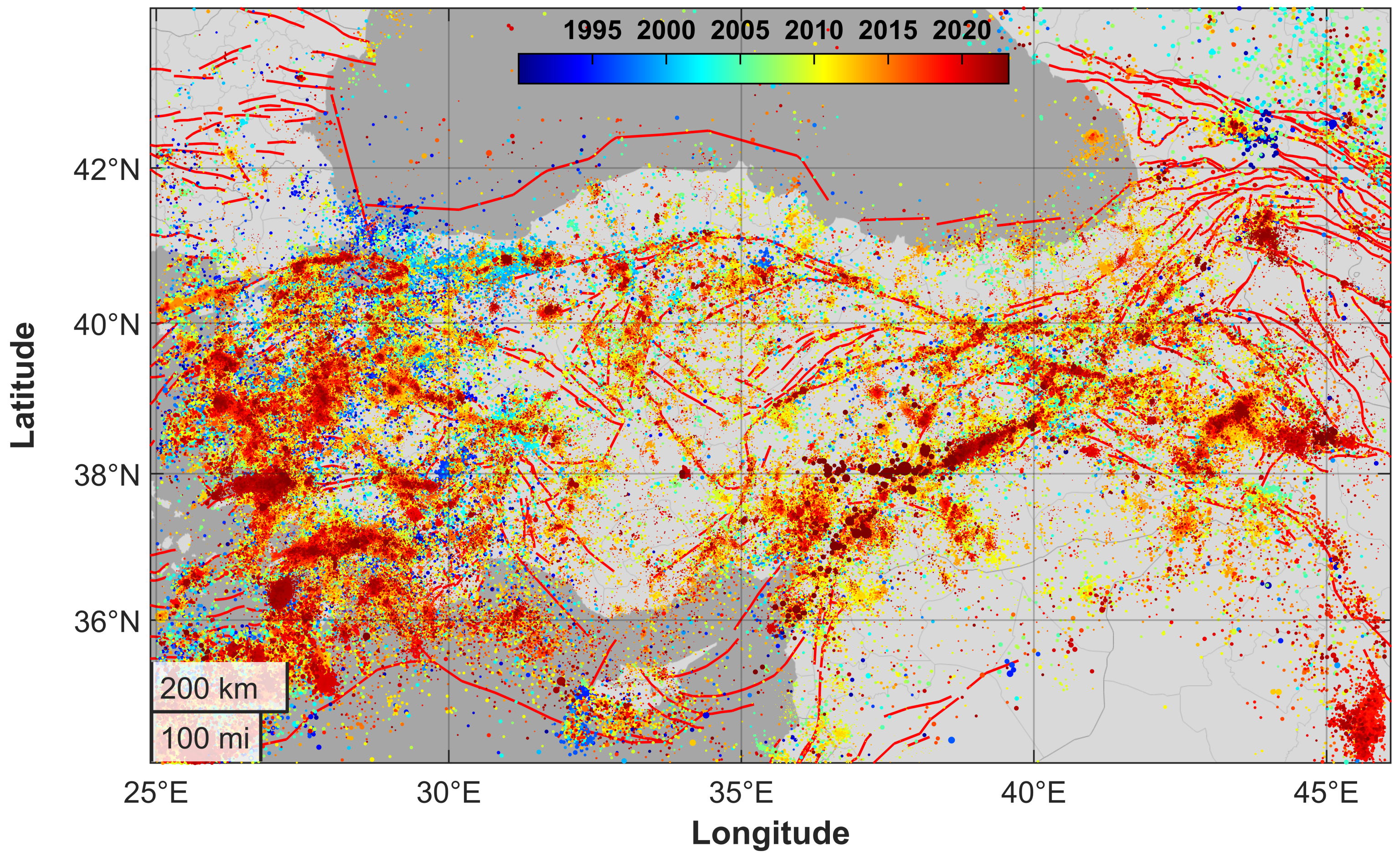
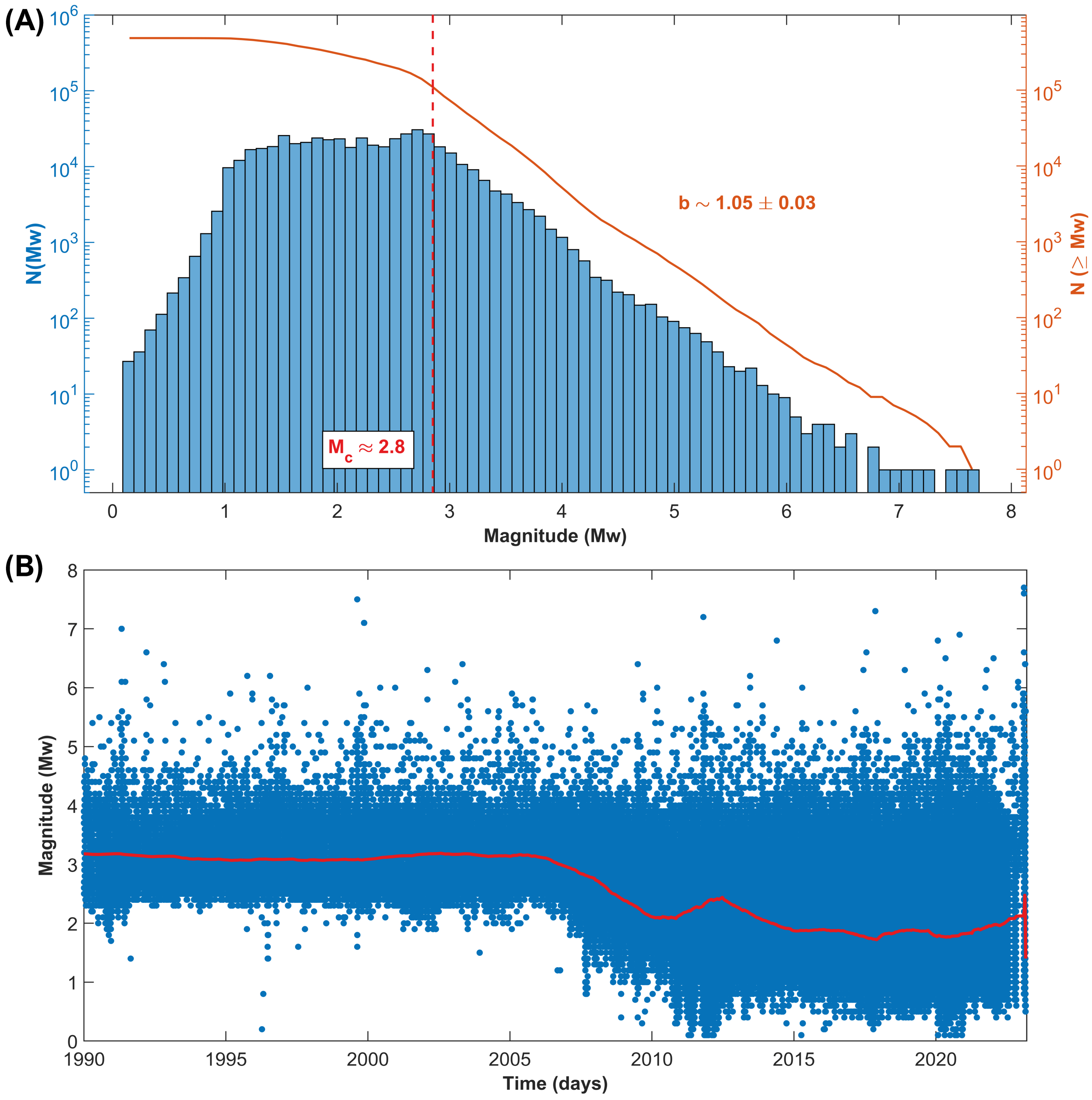
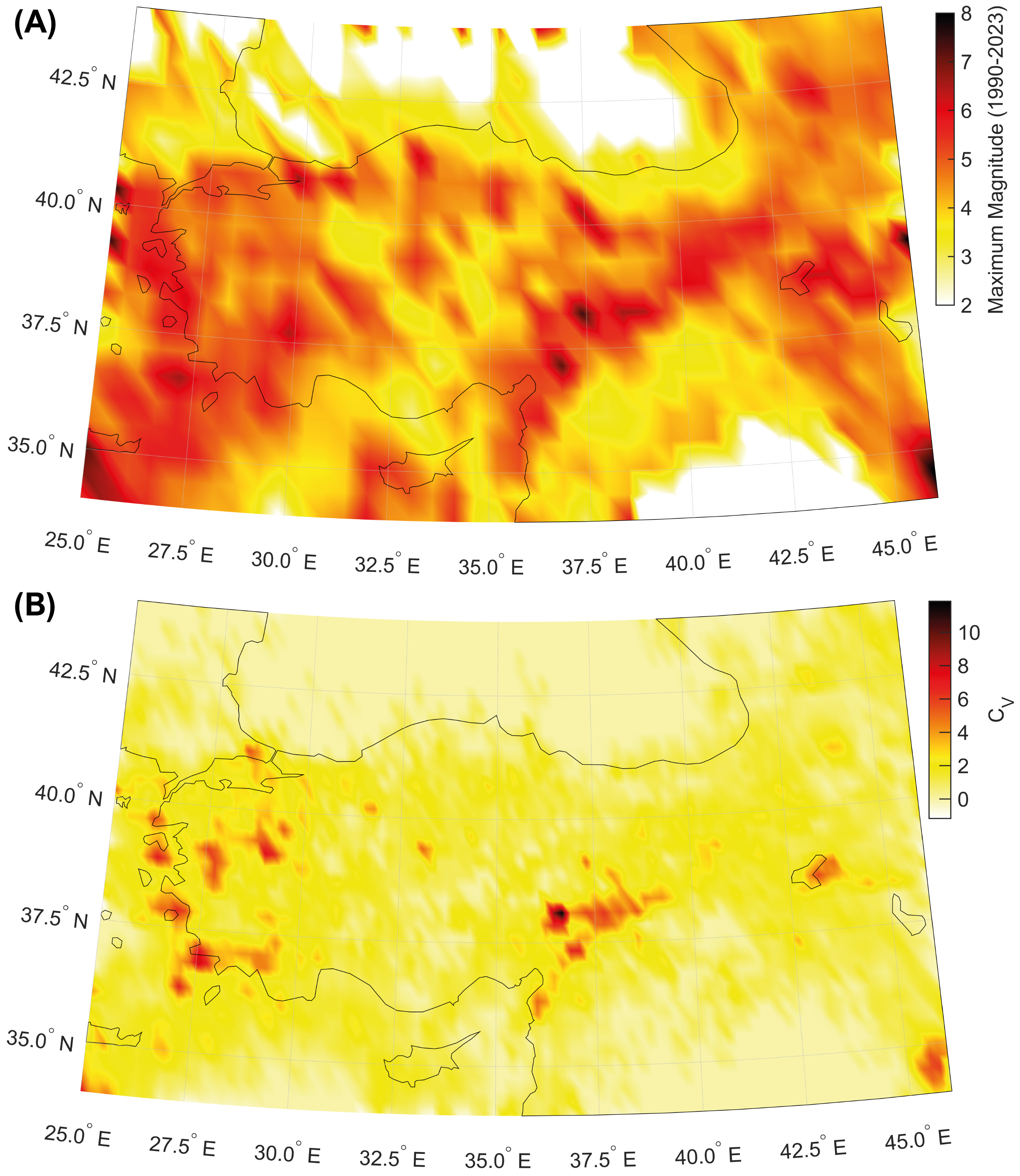
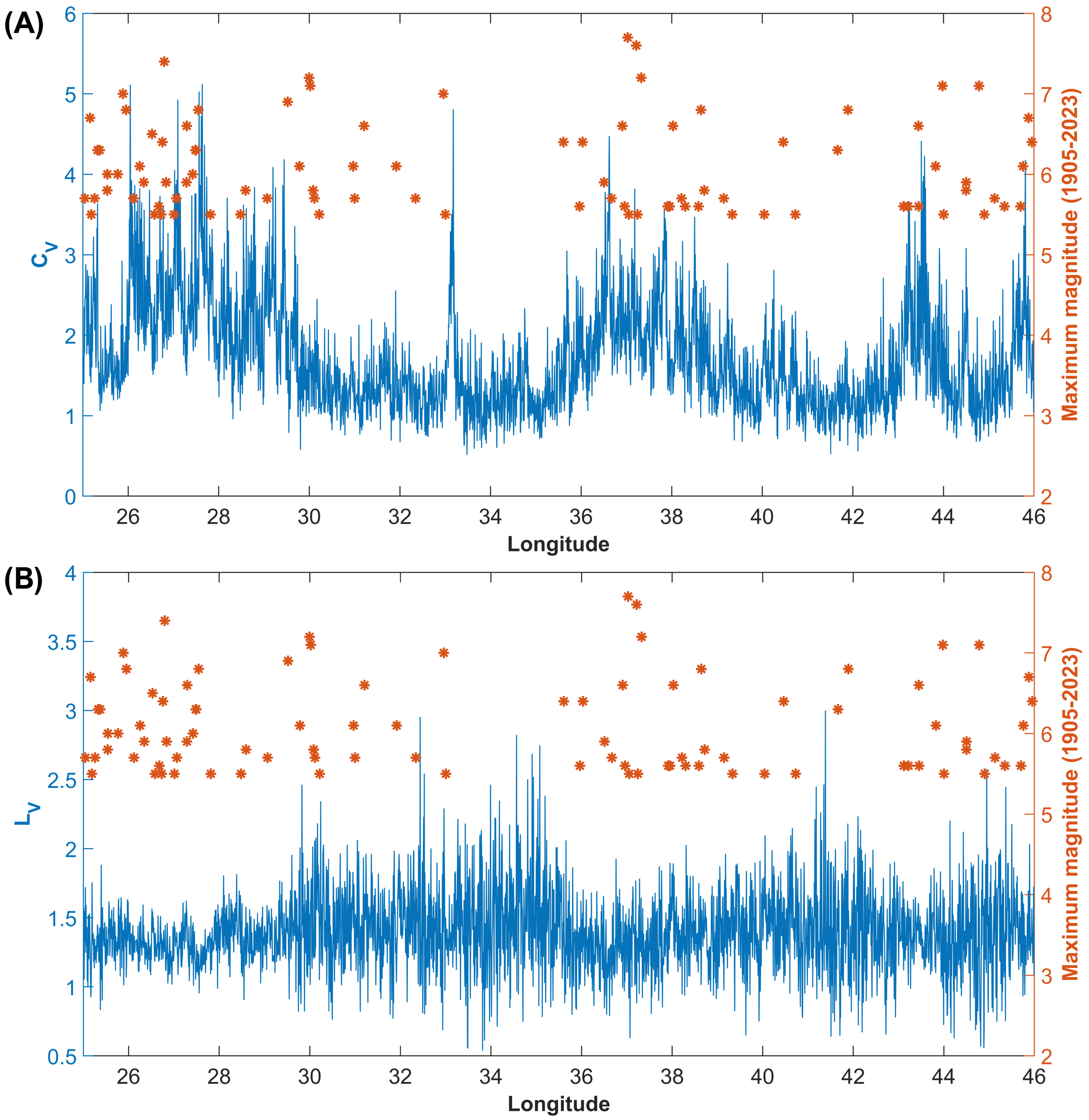
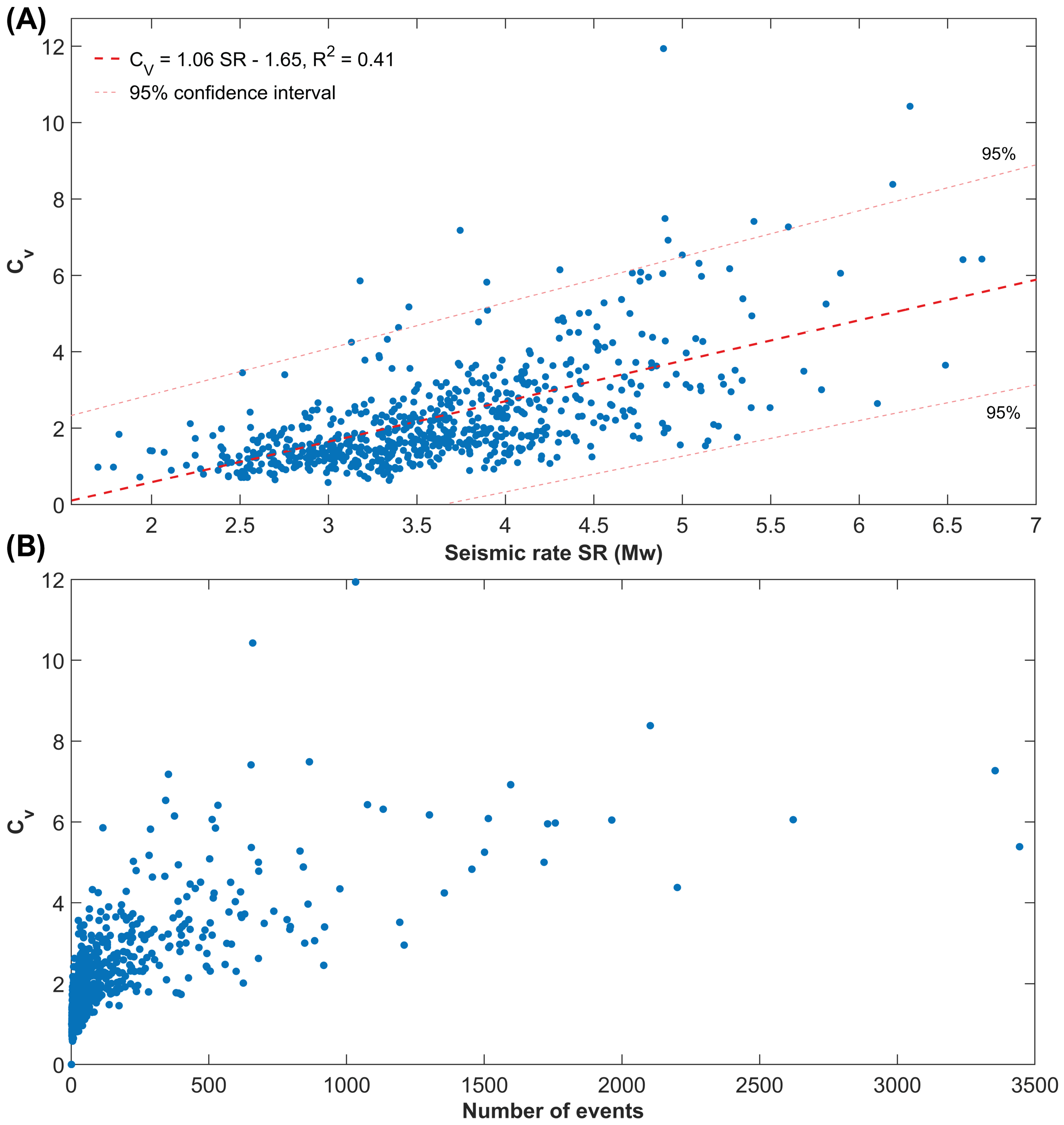


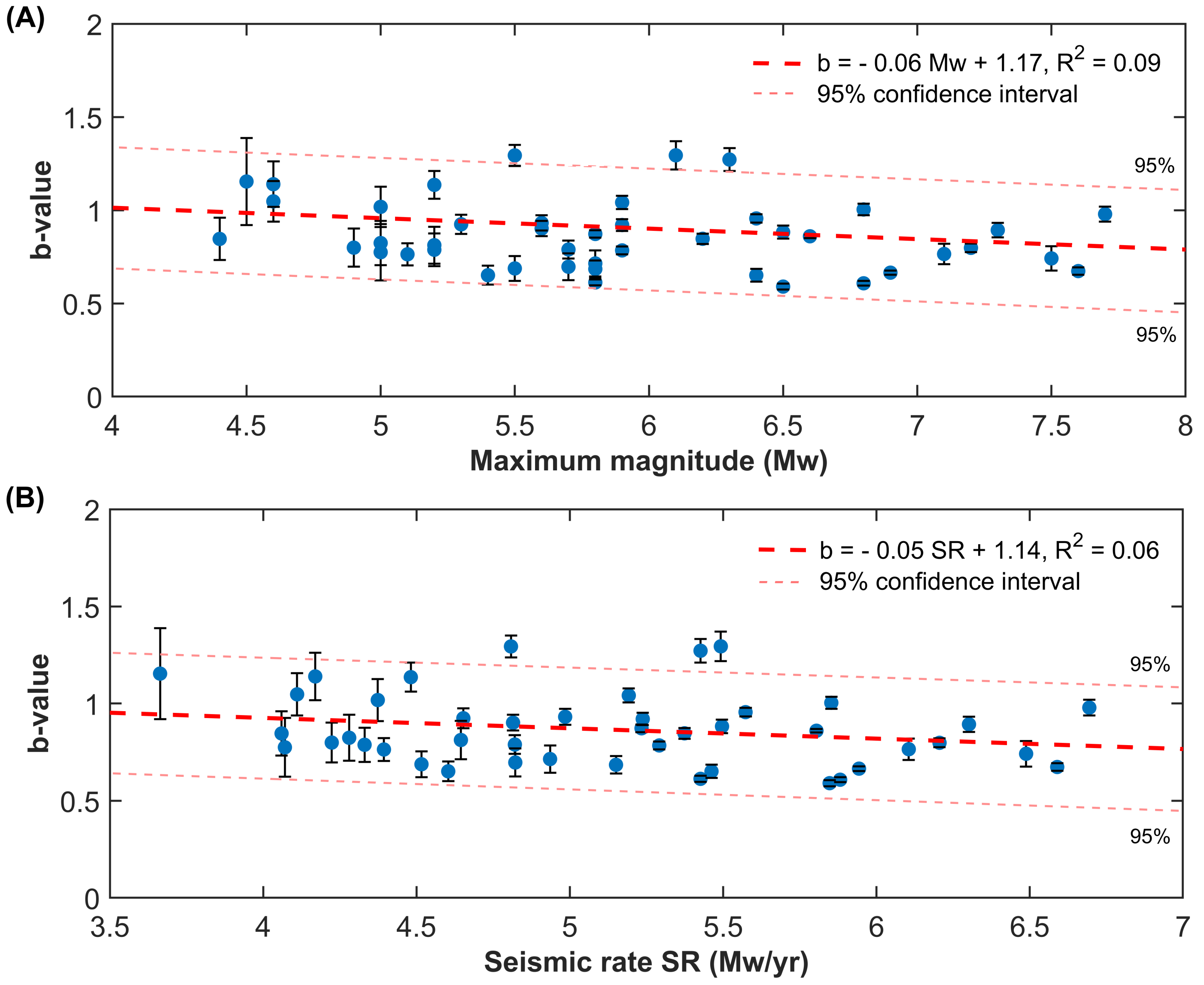
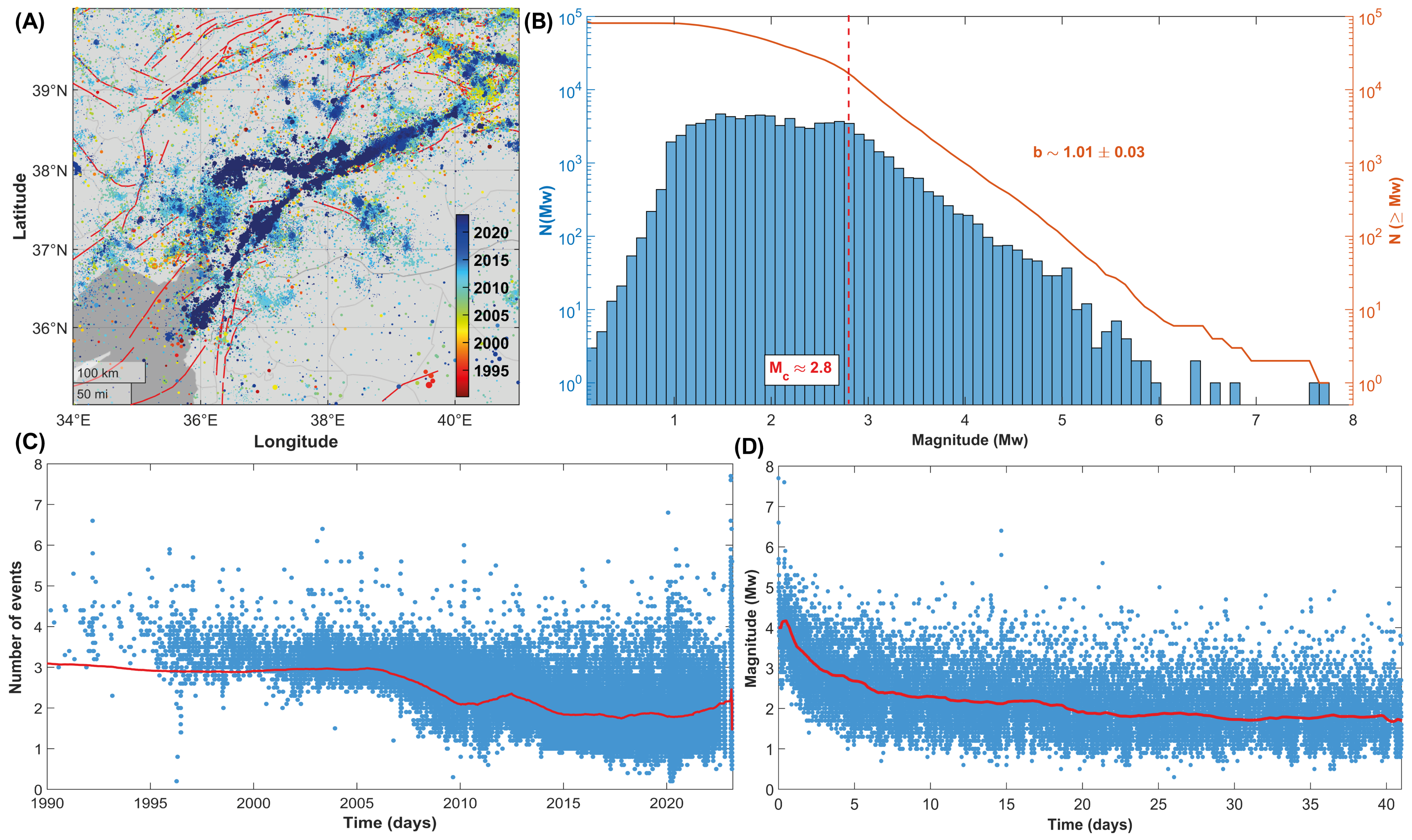

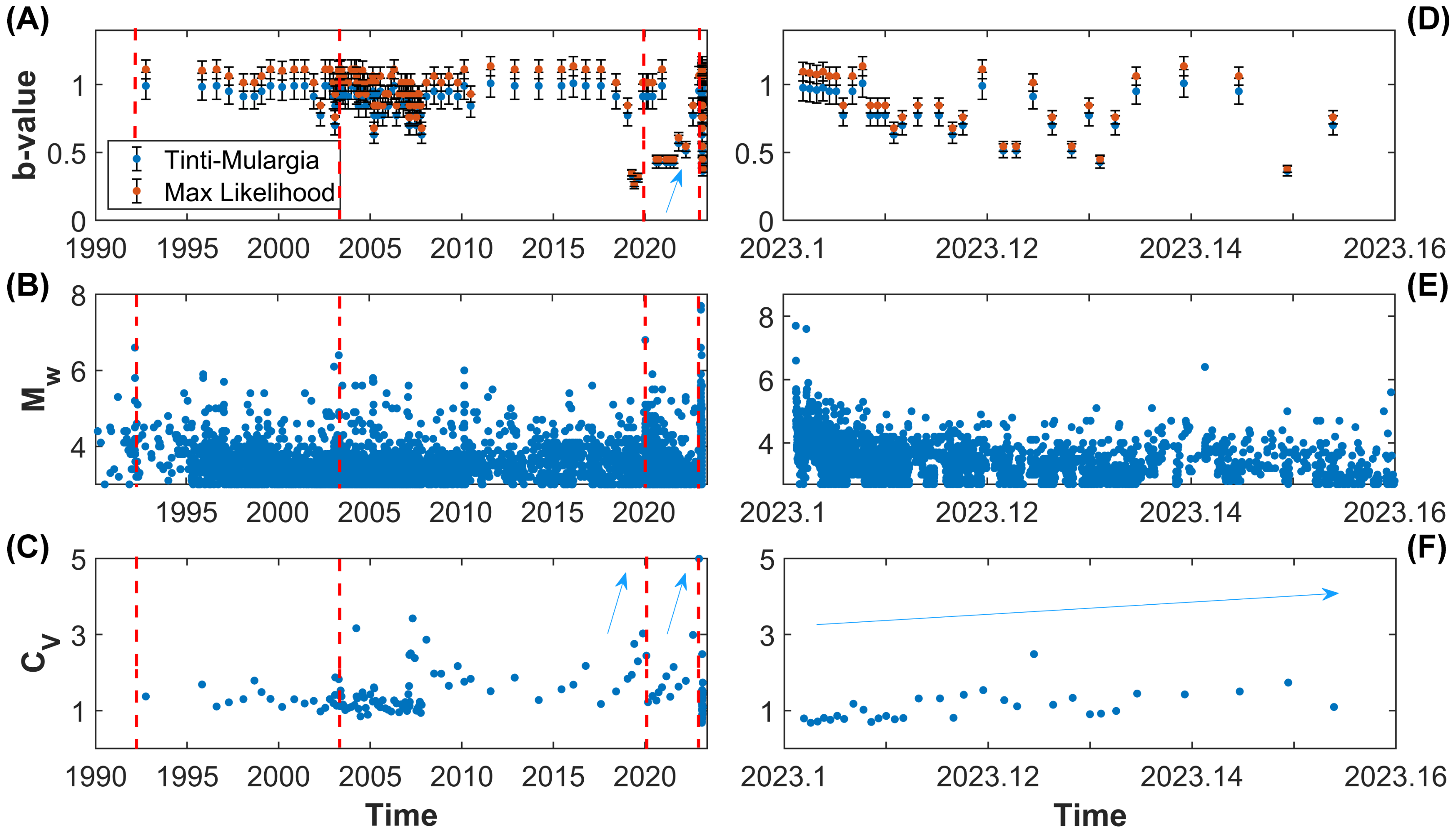
Disclaimer/Publisher’s Note: The statements, opinions and data contained in all publications are solely those of the individual author(s) and contributor(s) and not of MDPI and/or the editor(s). MDPI and/or the editor(s) disclaim responsibility for any injury to people or property resulting from any ideas, methods, instructions or products referred to in the content. |
© 2023 by the authors. Licensee MDPI, Basel, Switzerland. This article is an open access article distributed under the terms and conditions of the Creative Commons Attribution (CC BY) license (https://creativecommons.org/licenses/by/4.0/).
Share and Cite
Zaccagnino, D.; Telesca, L.; Tan, O.; Doglioni, C. Clustering Analysis of Seismicity in the Anatolian Region with Implications for Seismic Hazard. Entropy 2023, 25, 835. https://doi.org/10.3390/e25060835
Zaccagnino D, Telesca L, Tan O, Doglioni C. Clustering Analysis of Seismicity in the Anatolian Region with Implications for Seismic Hazard. Entropy. 2023; 25(6):835. https://doi.org/10.3390/e25060835
Chicago/Turabian StyleZaccagnino, Davide, Luciano Telesca, Onur Tan, and Carlo Doglioni. 2023. "Clustering Analysis of Seismicity in the Anatolian Region with Implications for Seismic Hazard" Entropy 25, no. 6: 835. https://doi.org/10.3390/e25060835
APA StyleZaccagnino, D., Telesca, L., Tan, O., & Doglioni, C. (2023). Clustering Analysis of Seismicity in the Anatolian Region with Implications for Seismic Hazard. Entropy, 25(6), 835. https://doi.org/10.3390/e25060835







